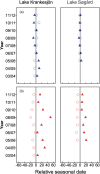Timing and synchrony of migration in a freshwater fish: Consequences for survival
- PMID: 35899786
- PMCID: PMC9805062
- DOI: 10.1111/1365-2656.13790
Timing and synchrony of migration in a freshwater fish: Consequences for survival
Abstract
Animal migration is one of the most spectacular and visible behavioural phenomena in nature with profound implications for a range of ecological and evolutionary processes. Successful migration hinges on the ability to exploit temporary resources (e.g. food) and evade threats (e.g. predators) as they arise, and thus the timing of migration is often regarded as a dominant predictor of individual migratory success. However, with the exception of intensively studied taxa (mainly birds), relatively few studies have investigated inter-individual annual and seasonal variation in migratory timing and performance, or tested predictions on how migration across high and low predation-risk habitats may exert selection on migratory timing. In particular, studies that assess the survival consequences of variation in migratory timing remain rare, which is most likely due to the logistical challenges associated with monitoring survival success and population-level characteristics simultaneously. Here, we address the above-mentioned questions using roach Rutilus rutilus, a fish that migrates from lakes characterised by high predation risk into low-risk streams during winter. Specifically, we used individual-based tracking of roach in two European lake systems over multiple migration periods (9 and 7 years respectively), to obtain highly detailed (year-round scheduling, repeat journeys and the fate of individuals) data on the variability/synchrony of migratory timing in spring and autumn respectively. We report seasonal differences in the variability of migratory timing, with lower variance and higher migration synchrony in spring lake arrival timing as compared to autumn lake departure timing. Furthermore, the timing of autumn migration is more variable across years than the timing of spring migration. Second, we find that later arrival to the lake habitat is positively associated with apparent survival from 1 year to the next, whereas we found no effect of lake departure timing on survival probability. These findings represent rare evidence showing how intraspecific variation in timing in migratory fish differs across years and seasons, and how variation in timing can translate into survival consequences for prey in systems characterised by high predation risk.
Keywords: aquatic ecology; individual differences; migration; movement ecology; predation risk; timing.
© 2022 The Authors. Journal of Animal Ecology published by John Wiley & Sons Ltd on behalf of British Ecological Society.
Conflict of interest statement
The authors declares that there is no conflict of interest.
Figures


Similar articles
-
Migration confers survival benefits against avian predators for partially migratory freshwater fish.Biol Lett. 2013 Feb 27;9(2):20121178. doi: 10.1098/rsbl.2012.1178. Print 2013 Apr 23. Biol Lett. 2013. PMID: 23445943 Free PMC article.
-
A foraging cost of migration for a partially migratory cyprinid fish.PLoS One. 2013 May 28;8(5):e61223. doi: 10.1371/journal.pone.0061223. Print 2013. PLoS One. 2013. PMID: 23723967 Free PMC article.
-
Maladaptive migration behaviour in hybrids links to predator-mediated ecological selection.J Anim Ecol. 2020 Nov;89(11):2596-2604. doi: 10.1111/1365-2656.13308. Epub 2020 Aug 23. J Anim Ecol. 2020. PMID: 32745243 Free PMC article.
-
Individual repeatability of avian migration phenology: A systematic review and meta-analysis.J Anim Ecol. 2022 Jul;91(7):1416-1430. doi: 10.1111/1365-2656.13697. Epub 2022 Apr 18. J Anim Ecol. 2022. PMID: 35385132 Free PMC article.
-
Population and evolutionary dynamics in spatially structured seasonally varying environments.Biol Rev Camb Philos Soc. 2018 Aug;93(3):1578-1603. doi: 10.1111/brv.12409. Epub 2018 Mar 25. Biol Rev Camb Philos Soc. 2018. PMID: 29575449 Free PMC article. Review.
Cited by
-
Facilitated migration could bolster migrant passage through anthropogenically altered ecosystems.Ecol Appl. 2025 Jul;35(5):e70070. doi: 10.1002/eap.70070. Ecol Appl. 2025. PMID: 40605740 Free PMC article.
-
Diverse environmental cues drive the size of reproductive aggregation in a rheophilic fish.Mov Ecol. 2023 Mar 22;11(1):16. doi: 10.1186/s40462-023-00379-0. Mov Ecol. 2023. PMID: 36949527 Free PMC article.
-
The Fragile First Year: GPS Tracking Identifies Post-Release Survival Risks in Migratory Geese.Ecol Evol. 2025 Jul 4;15(7):e71725. doi: 10.1002/ece3.71725. eCollection 2025 Jul. Ecol Evol. 2025. PMID: 40625318 Free PMC article.
-
Will I stay or will I go? Eye morphology predicts individual migratory propensity in a partial migrant.J Anim Ecol. 2025 May;94(5):874-883. doi: 10.1111/1365-2656.70015. Epub 2025 Feb 27. J Anim Ecol. 2025. PMID: 40017146 Free PMC article.
References
-
- Alerstam, T. , Hake, M. , & Kjellen, N. (2006). Temporal and spatial patterns of repeated migratory journeys by ospreys. Animal Behaviour, 71, 555–566.
-
- Altizer, S. , Bartel, R. , & Han, B. A. (2011). Animal migration and infectious disease risk. Science, 331, 296–302. - PubMed
-
- Batschelet, E. (1981). Circular statistics in biology. Academic Press.
-
- Bauer, S. , & Hoye, B. J. (2014). Migratory animals couple biodiversity and ecosystem functioning worldwide. Science, 344, 1242552. - PubMed

